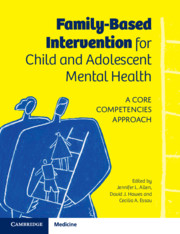Book contents
- Family-Based Intervention for Child and Adolescent Mental Health
- Family-Based Intervention for Child and Adolescent Mental Health
- Copyright page
- Contents
- Contributors
- Preface
- Part I Theoretical Perspectives on Family-Based Intervention
- Chapter 1 A Core-Competency Perspective on Family-Based Intervention for Child and Adolescent Mental Health
- Chapter 2 The Role of the Family in Child and Adolescent Psychopathology
- Chapter 3 Implementation of Family-Based Intervention
- Chapter 4 Effective Components of Parenting Programmes for Children’s Conduct Problems
- Part II Core Clinical Competencies
- Part III Family Intervention for Specific Child and Adolescent Mental Health Problems
- Part IV Family Intervention for Children at Risk Due to Family Dysfunction or Past Adversity
- Part V New Developments in Family-Based Intervention
- Index
- References
Chapter 1 - A Core-Competency Perspective on Family-Based Intervention for Child and Adolescent Mental Health
from Part I - Theoretical Perspectives on Family-Based Intervention
Published online by Cambridge University Press: 18 February 2021
- Family-Based Intervention for Child and Adolescent Mental Health
- Family-Based Intervention for Child and Adolescent Mental Health
- Copyright page
- Contents
- Contributors
- Preface
- Part I Theoretical Perspectives on Family-Based Intervention
- Chapter 1 A Core-Competency Perspective on Family-Based Intervention for Child and Adolescent Mental Health
- Chapter 2 The Role of the Family in Child and Adolescent Psychopathology
- Chapter 3 Implementation of Family-Based Intervention
- Chapter 4 Effective Components of Parenting Programmes for Children’s Conduct Problems
- Part II Core Clinical Competencies
- Part III Family Intervention for Specific Child and Adolescent Mental Health Problems
- Part IV Family Intervention for Children at Risk Due to Family Dysfunction or Past Adversity
- Part V New Developments in Family-Based Intervention
- Index
- References
Summary
The training of mental health practitioners has seen a growing focus on core competencies in recent years in response to the need for guidance in the implementation of evidence-based treatment of mental disorders. This chapter outlines the aims and advantages of a competency-based approach and describes existing models of competencies in the treatment of adults, children and adolescents. For the most part, existing models have focused on cognitive behavioural therapy (CBT) to the exclusion of other evidence-based approaches and on individual therapy at the expense of treatment in which family members are actively involved. We present a novel model of the therapist competencies needed for the effective delivery of evidence-based family interventions for common child and adolescent mental health disorders. The proposed framework provides a potential foundation for curricula planning and assessment in practitioner training and stands to inform evidence-based practice guidelines and future research into professional development.
Keywords
- Type
- Chapter
- Information
- Family-Based Intervention for Child and Adolescent Mental HealthA Core Competencies Approach, pp. 1 - 13Publisher: Cambridge University PressPrint publication year: 2021
References
- 1
- Cited by

